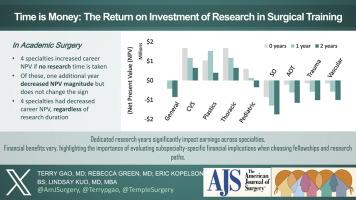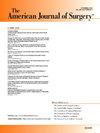Time is money: The return on investment of research in surgical training
IF 2.7
3区 医学
Q1 SURGERY
引用次数: 0
Abstract
Introduction
Future income potential can impact surgical trainees’ career choices, particularly when deciding to subspecialize, which often requires additional training and research time. This study quantifies the effects of added time on career value for eight surgical subspecialties.
Methods
The Net present value(NPV) was calculated for eight subspecialties and general surgery over a 35-year career, factoring in salary, educational debt, tax, inflation, and practice setting. NPV for each was compared over a number of research years (0, 1, 2) using data from the MGMA, AAMC, and US government records.
Results
After a 35-year career, six subspecialties in private practice increased career NPV(>$14,000) with 0 research years. One additional research year yielded negative career values for transplant, trauma, and vascular; with two, only cardiovascular and pediatric retained a positive NPV. In academia, 1–2 research years resulted in negative NPV for all but cardiovascular and thoracic surgery.
Conclusions
The financial return of additional training years is highly variable.

时间就是金钱:外科培训研究的投资回报
导言未来的收入潜力会影响外科学员的职业选择,尤其是在决定从事亚专科时,这通常需要额外的培训和研究时间。本研究量化了八个外科亚专科增加时间对职业价值的影响。方法计算了八个亚专科和普通外科 35 年职业生涯的净现值(NPV),其中考虑了工资、教育债务、税收、通货膨胀和执业环境等因素。使用来自 MGMA、AAMC 和美国政府记录的数据,比较了每个亚专科在不同研究年限(0、1、2)下的净现值。在移植、创伤和血管领域,多一个研究年会产生负的职业净现值;多两个研究年,只有心血管和儿科保留了正的净现值。在学术界,除心血管和胸外科外,1-2 个研究年的净现值均为负值。
本文章由计算机程序翻译,如有差异,请以英文原文为准。
求助全文
约1分钟内获得全文
求助全文
来源期刊
CiteScore
5.00
自引率
6.70%
发文量
570
审稿时长
56 days
期刊介绍:
The American Journal of Surgery® is a peer-reviewed journal designed for the general surgeon who performs abdominal, cancer, vascular, head and neck, breast, colorectal, and other forms of surgery. AJS is the official journal of 7 major surgical societies* and publishes their official papers as well as independently submitted clinical studies, editorials, reviews, brief reports, correspondence and book reviews.

 求助内容:
求助内容: 应助结果提醒方式:
应助结果提醒方式:


